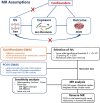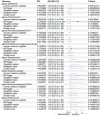Causal relationship between gut microbiota and polycystic ovary syndrome: a literature review and Mendelian randomization study
- PMID: 38362275
- PMCID: PMC10867277
- DOI: 10.3389/fendo.2024.1280983
Causal relationship between gut microbiota and polycystic ovary syndrome: a literature review and Mendelian randomization study
Abstract
Introduction: Numerous studies have suggested an association between gut microbiota and polycystic ovarian syndrome (PCOS). However, the causal relationship between these two factors remains unclear.
Methods: A review of observational studies was conducted to compare changes in gut microbiota between PCOS patients and controls. The analysis focused on four levels of classification, namely, phylum, family, genus, and species/genus subgroups. To further investigate the causal relationship, Mendelian randomization (MR) was employed using genome-wide association study (GWAS) data on gut microbiota from the MiBioGen consortium, as well as GWAS data from a large meta-analysis of PCOS. Additionally, a reverse MR was performed, and the results were verified through sensitivity analyses.
Results: The present review included 18 observational studies that met the inclusion and exclusion criteria. The abundance of 64 gut microbiota taxa significantly differed between PCOS patients and controls. Using the MR method, eight bacteria were identified as causally associated with PCOS. The protective effects of the genus Sellimonas on PCOS remained significant after applying Bonferroni correction. No significant heterogeneity or horizontal pleiotropy was found in the instrumental variables (IVs). Reverse MR analyses did not reveal a significant causal effect of PCOS on gut microbiota.
Conclusion: The differences in gut microbiota between PCOS patients and controls vary across observational studies. However, MR analyses identified specific gut microbiota taxa that are causally related to PCOS. Future studies should investigate the gut microbiota that showed significant results in the MR analyses, as well as the underlying mechanisms of this causal relationship and its potential clinical significance.
Keywords: Mendelian randomization; causation; gut microbiota; polycystic ovarian syndrome; review.
Copyright © 2024 Sun, Wang and Kan.
Conflict of interest statement
The authors declare that the research was conducted in the absence of any commercial or financial relationships that could be construed as a potential conflict of interest.
Figures





Similar articles
-
Gut microbiota and polycystic ovary syndrome, focus on genetic associations: a bidirectional Mendelian randomization study.Front Endocrinol (Lausanne). 2024 Jan 22;15:1275419. doi: 10.3389/fendo.2024.1275419. eCollection 2024. Front Endocrinol (Lausanne). 2024. PMID: 38318294 Free PMC article.
-
Causal relationships between gut microbiota and polycystic ovarian syndrome: A bidirectional Mendelian randomization study.Acta Obstet Gynecol Scand. 2024 Nov;103(11):2232-2241. doi: 10.1111/aogs.14957. Epub 2024 Sep 10. Acta Obstet Gynecol Scand. 2024. PMID: 39254198 Free PMC article.
-
The association between gut microbiome and PCOS: evidence from meta-analysis and two-sample mendelian randomization.Front Microbiol. 2023 Jul 24;14:1203902. doi: 10.3389/fmicb.2023.1203902. eCollection 2023. Front Microbiol. 2023. PMID: 37555058 Free PMC article.
-
The gut microbiota and diabetic nephropathy: an observational study review and bidirectional Mendelian randomization study.Trials. 2025 Mar 24;26(1):101. doi: 10.1186/s13063-025-08755-4. Trials. 2025. PMID: 40122887 Free PMC article. Review.
-
Genetic liability of gut microbiota for idiopathic pulmonary fibrosis and lung function: a two-sample Mendelian randomization study.Front Cell Infect Microbiol. 2024 May 22;14:1348685. doi: 10.3389/fcimb.2024.1348685. eCollection 2024. Front Cell Infect Microbiol. 2024. PMID: 38841114 Free PMC article.
Cited by
-
Unraveling intestinal microbiota's dominance in polycystic ovary syndrome pathogenesis over vaginal microbiota.Front Cell Infect Microbiol. 2024 Mar 28;14:1364097. doi: 10.3389/fcimb.2024.1364097. eCollection 2024. Front Cell Infect Microbiol. 2024. PMID: 38606298 Free PMC article.
-
Gut Microbiota and Oral Contraceptive Use in Women with Polycystic Ovary Syndrome: A Systematic Review.Nutrients. 2024 Oct 4;16(19):3382. doi: 10.3390/nu16193382. Nutrients. 2024. PMID: 39408349 Free PMC article.
-
Reducing the Risk of Pre-Eclampsia in Women with Polycystic Ovary Syndrome Using a Combination of Pregnancy Screening, Lifestyle, and Medical Management Strategies.J Clin Med. 2024 Mar 20;13(6):1774. doi: 10.3390/jcm13061774. J Clin Med. 2024. PMID: 38541997 Free PMC article. Review.
-
Irisin alleviated the reproductive endocrinal disorders of PCOS mice accompanied by changes in gut microbiota and metabolomic characteristics.Front Microbiol. 2024 May 23;15:1373077. doi: 10.3389/fmicb.2024.1373077. eCollection 2024. Front Microbiol. 2024. PMID: 38846566 Free PMC article.
-
Unraveling the gut microbiota's role in PCOS: a new frontier in metabolic health.Front Endocrinol (Lausanne). 2025 Mar 18;16:1529703. doi: 10.3389/fendo.2025.1529703. eCollection 2025. Front Endocrinol (Lausanne). 2025. PMID: 40171188 Free PMC article. Review.
References
Publication types
MeSH terms
LinkOut - more resources
Full Text Sources
Medical
Miscellaneous

